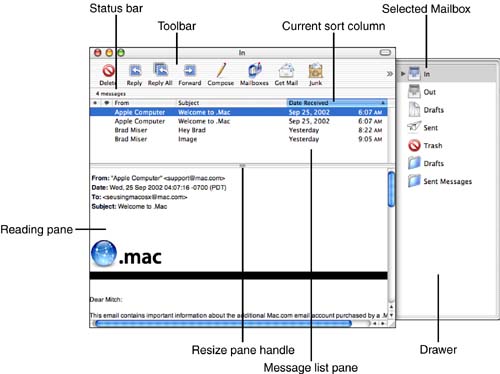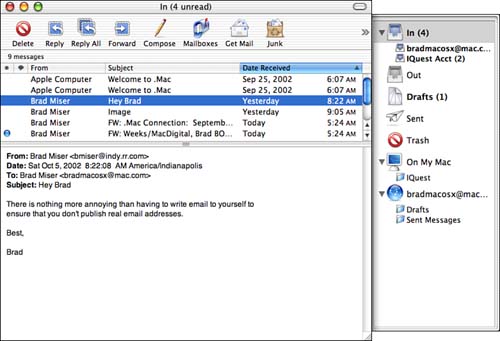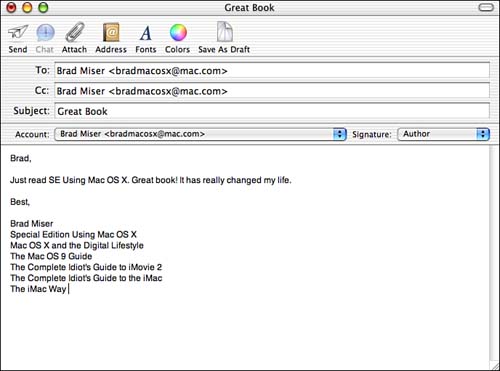Sending, Receiving, and Replying to E-Mail
| If you have used an e-mail application before, such as Outlook Express, Entourage, or Eudora, using Mail to send, receive, and reply to e-mail will be familiar to you after you learn about the Mail interface. The main Mail window has three panes. The top pane contains the Mail Toolbar and the Status Bar. The second pane from the top is the Message List, in which you see the list of items in a selected mailbox. The lower pane of the Mail window is the reading pane in which you read a mail item that is selected in Message List. All your mailboxes are in the Mail Drawer, which is a window that pops out of either side of the main Mail window (see Figure 12.14). Figure 12.14. The Mail application uses three panes to enable you to browse, view, and organize your e-mail.
The Message pane of the Mail window behaves much like a Finder in List view. For example, you can change the width of the columns, sort the window, and so on. The columns in the default Mail window are the following (from left to right as in Figure 12.14):
The Mailbox drawer shows all of your mailboxes. You can open the Mailbox Drawer by choosing View, Show Drawer (Shift+ You can expand or collapse the contents of a mailbox by using its Expansion triangle. The Drawer contains several mailboxes and folders by default. The Inbox is used to store all of your received mail (you can use a rule to send e-mail from there to any other location in the Drawer). You also see Out, Drafts, Sent, and Trash mailboxes; the purpose of these should be evident. You might also see Drafts and Sent Messages folders for specific types of e-mail accounts. Retrieving and Reading E-MailThere are several ways to retrieve e-mail from your accounts.
NOTE The first four methods listed retrieve mail for all the e-mail accounts you have configured in Mail (for those accounts that are enabled and that you set to be included in the retrieve all action using that account's options settings). TIP You can temporarily hide the Reading pane by double-clicking the border between the Message List and the Reading pane. The Reading pane will disappear and the Message list will consume the entire Mail window. Double-click the bottom of the Mail window to reopen the Reading pane. When you get mail, it is placed in the In mailbox. When you receive e-mail, Mail's Dock icon indicates that you have new e-mail and shows you the total number of new messages you have received. If you chose to have Mail play a sound when new mail is received, you will hear that sound. When you click and hold (or Control+click) the Mail icon on the Dock, a list pops up that shows you all the windows that are open in Mail, as well as some useful commands (see Figure 12.15). Figure 12.15. When you receive new mail, Mail lets you know how many messages you have received (three in this case); you can quickly access the mailboxes containing the new messages by Control+clicking the Mail icon on the Dock and selecting your In mailbox.
When you select In on the Dock menu, you will move into Mail to read your e-mail; each unread message will have a blue dot in the Read/Unread column to indicate that it is a new message. You will also see the number of new messages indicated next to the In mailbox. If you have more than one e-mail account, each account has its own Inbox. To see all of your inboxes, click the Expansion arrow next to the In folder (see Figure 12.16). You will see the Inbox for each of your accounts. Select an Inbox to see the messages for that account only, or choose the In folder to see all of your messages at the same time. Figure 12.16. Each of my e-mail accounts has its own Inbox, as you can see listed under the In folder.
TIP In Mail, you can display the contents of more than one mailbox at a time. To do so, choose File, New View Window (Option+
NOTE You can see the activity of Mail as it downloads messages using its Activity Viewer. To see the Activity Viewer, choose Window, Show Activity Viewer (or press The Status bar just above the Message List pane tells you the number of messages in the currently selected mailbox. When Mail is doing something, such as retrieving e-mail, you also see the activity icon at the right end of the Status Line. To view the contents of a mailbox, select it in the Drawer. The Message list will show the messages contained in that mailbox. To read a message, select it in the Message list and read it in the Reading pane. To read your mail, use the following shortcuts:
TIP If the mailbox you are viewing has lots of messages in it, select those that are interesting to you; hold down the Shift key to select contiguous messages or hold down the Writing and Sending E-MailWriting e-mail in Mail is also quite similar to other e-mail applications. You can create a new mail message in several ways, including the following:
You will see the New Message window (see Figure 12.17). Creating the message is straightforward. If the message is not already addressed, type the e-mail address in the To and Cc fields. Mail will attempt to match what you type to the addresses in your Address Book. The addresses that match what you type will appear on a drop-down list. You can move up and down this list with the Up- and Down-arrow keys. To select an address on the list, highlight it and it will be entered in the message's To box. (If there is only one address for the name you type, it is selected by default.) You can enter multiple addresses in an address field by typing a comma and then repeating the previous steps to add more addresses. When you have added all the addresses in the To field, press Tab to move to the next field. Figure 12.17. If you have used other e-mail applications, Mail's New Message window will no doubt look familiar.
TIP When an address is selected on the drop-down list, you can add it to the message and be ready to enter the next address by pressing comma. To use your Address Book to address a message, open the Address Book by clicking the Address icon on the New Message window's toolbar or by pressing Option+ TIP You can add a Bcc (blind carbon copy) address line by choosing Edit, Add Bcc Header or by pressing Shift+ Enter the subject of the message in the Subject field. Choose the account from which you want to send the mail using the Account pop-up menu (your default account is listed automatically). You determine which account is the default account selected on the Account menu by the order in which your accounts are listed on the Accounts pane of the Preferences window or by the Inbox you have selected (the account that the currently selected Inbox is associated with will appear at the top of the Account list on the Account pop-up menu). The account that is highest in the Preferences window will be listed in the Account pop-up menu automatically. To change the order of the accounts, drag them up or down in the window. TIP The New Message window has its own toolbar; you can customize its toolbar just as you can other Mac OS X toolbars (View, Customize Toolbar). Choose the signature you want to use from the Signature pop-up menu. Move into the body and type your message. As you type, Mail will check your spelling. When it identifies a misspelled word, it underlines the word in red. You can Control+click a misspelled word to pop up a menu enabling you to change the word to the correct spelling, ignore the spelling, or learn the word that Mail thinks is misspelled. TIP You can control Mail's spell checker using the commands on the Edit menu. You can open the Spelling window by choosing Edit, Spelling, and then Spelling again. You can check the spelling in a message by choosing Edit, Spelling, and then Check Spelling. You can turn Check Spelling As You Type off by choosing Edit, Spelling, Check Spelling As You Type. NOTE Because I encourage the use of plain text e-mail rather than formatted e-mail, I won't be addressing formatting e-mail in this chapter. However, if you choose to create Rich Text messages, use the commands on the Format menu to format them. You can change the format of a new message by moving the pointer into the body of a new message and opening the contextual menu. Choose Make Rich Text to enable formatting of your message. As you work with your message, open its contextual menu to gain quick access to various commands, such as formatting commands for a Rich Text message, Spell Checker controls, and quoting commands. To send a message, do one of the following:
TIP While you're composing a message, you can save it in the Draft mailbox by choosing File, Save As Draft (
Replying to E-MailReplying to messages you receive in Mail is also quite similar to other applications. By default, Mail marks the different levels of quoting with different colors along with a change bar. As with other applications, you can select the message to which you want to reply and click Reply on the toolbar; choose Message, Reply to Sender; or press You can use the same tools to reply to a message as you use to write a new message. NOTE You should always quote carefully in your replies. Quoting makes e-mail much more effective because it gives the reader a good context for the information you are providing. Quoting is one reason that I prefer plain text messages. It is much easier to quote in a plain text message; formatting often gets in the way of clear quoting. Deleting E-MailYou can delete messages by selecting the messages you want to delete and doing one of the following:
Deleted messages are stored in the Trash folder in the Drawer. You can open this folder just like other folders you have. Messages aren't actually removed until the Trash folder is emptied. When you use an IMAP account, such as a .Mac e-mail account, you have to empty the Trash folder to actually remove the messages from the server. If you don't, those messages continue to count against the total storage space you have on the server. Typically, you are limited to a certain storage space for all of your messages (under an IMAP account, all your messages remain on the server). Because messages in the Trash folder count against this limit, you should empty this folder more frequently under an IMAP account than you have to do with POP accounts. Because they are actually IMAP accounts, .Mac e-mail accounts are limited to a certain amount of storage. If the messages stored in your .Mac e-mail account approach or exceed this limit, you will receive e-mail messages warning you that you are exceeding your allotted storage space. To move messages off of the server, you need to move them from the Inbox for that account to one of your personal mailboxes that are stored on your Mac or to the Trash and then empty it. You can determine whether deleted messages are stored on the server by using the Special Mailboxes tab of the Account sheet that you open in the Mail Preferences window. Open this tab and uncheck the "Store deleted messages on the server" check box. This will cause the messages you delete to be downloaded to your Mac, so they won't count against your storage limit. You can also use the Permanently erase deleted message when pop-up menu to select a time period for your deleted messages to be permanently erased. |
EAN: 2147483647
Pages: 260



